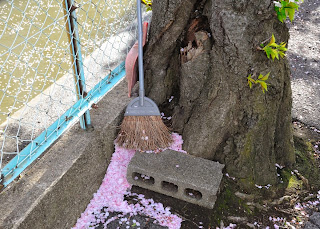Explorations and experiments in visual representations - multimodality, sensory ethnography, reflexivity, autoethnographic vignettes, ethnographic photography and ba...

Tuesday, April 22, 2014
"Digital eyes show your emotions for you"
Photo and text from Japan Today, 4/22/14.
Can’t be bothered to show anyone what you’re thinking? Then a Japanese scientist has the answer—a pair of digital eyes that can express delight and anger, or even feign boredom.
Building on a long line of slightly wacky and not-very-practical inventions for which Japan is famous, Hirotaka Osawa has unveiled the “AgencyGlass”.
“I wanted to build a system that is capable of carrying out social behaviors for humans,” he told AFP.
Just as robots can reduce the need for physical labor, the AgencyGlass—which looks like two small TV screens set in spectacle frames—aims to cut down its user’s emotional demands by carrying out their eye movements for them.
The two organic light-emitting diode (OLED) screens, which are connected to motion sensors and an external camera, show a pair of eyeballs that can appear to be making eye contact while the wearer is looking somewhere else entirely.
The wearer has to choose their emotion in advance—if they want to appear “attentive”, for example, they must switch it to this mode before putting the glasses on.
Osawa, of the prestigious Tsukuba University, said possible applications include for flight attendants dealing with irritating passengers, or teachers who want to project an image of kindness towards shy students.
“As the service sector grows and becomes more sophisticated, it becomes increasingly important that we behave by showing understanding to others,” he said. “That requires us to behave differently from our true feelings.”
Such “emotional labor” has caused some people to become deeply conflicted and develop emotional illnesses, Osawa said, adding that his technology could eventually help them.
The glasses weigh around 100 grams with the battery lasting roughly an hour, Osawa said, adding that the prototype cost just over 30,000 yen to make. They are currently not in production.
Source: http://www.japantoday.com/category/technology/view/digital-eyes-show-your-emotions-for-you-2
Saturday, April 19, 2014
Friday, April 11, 2014
Friday Fun! "This [American] Sign Language Rap Battle Is Unlike Anything You've Ever Seen"
This is way too cool. Thanks to my colleague MH for sharing this with me. Check it out!
Again, very cool. But one might ask why was a stoned rapper asked to judge the interpreters? Where were the deaf people?
Source: http://www.huffingtonpost.com/2014/04/08/sign-language-rap-battle_n_5112402.html?utm_hp_ref=mostpopular
Again, very cool. But one might ask why was a stoned rapper asked to judge the interpreters? Where were the deaf people?
Source: http://www.huffingtonpost.com/2014/04/08/sign-language-rap-battle_n_5112402.html?utm_hp_ref=mostpopular
Monday, April 7, 2014
"Stores sharing biometric face data"
Image and text from The Japan News, 4/6/14.
Automatically recorded images by security cameras of shoppers’ faces have been shared among 115 supermarkets and convenience stores in the Tokyo metropolitan and another area as an antishoplifting measure, without customers’ knowledge, The Yomiuri Shimbun has learned.
Although the images are used mainly to prevent shoplifting, experts and industry bodies say it is necessary to make clear rules because providing people’s facial data to a third party could constitute an invasion of privacy.
The facial data in question was shared by 115 stores of 50 separate operators that have installed a shoplifting prevention system that a Nagoya-based software development company began marketing in October last year. The stores include major convenience stores operated by individuals under franchise contracts.
At these shops, security cameras film all customers’ faces. If a person shoplifts or makes an unreasonable complaint at one of the stores, security camera footage of the person is processed into facial data with the recognition system and classified into categories such as “shoplifter” and “complainer.”
They are then sent to the software firm’s server to be recorded. The facial images themselves cannot be browsed from other stores.
Once registered on the digital blacklist, however, a warning is issued to the staff of other stores—in a way only the staff can notice—when the face recognition system installed at these stores detects the blacklisted person visiting their stores.
At these stores, stickers are placed within the stores to inform customers that “face recognition security cameras are installed.” But customers are not informed that the stores are sharing the facial data.
Facial recognition—done through computer analysis of a person’s face—is a type of biometric recognition system used to confirm identity, age or sex, along with other specifics of individuals. Unlike fingerprints or iris recognition systems, it can collect information on individuals’ facial data when the subjects pass by security cameras. Facial recognition systems are known to identify a specific person with an accuracy rate of at least 99.9% and are used to identify terrorists at such places as airports.
Under the Personal Information Protection Law, facial images filmed by security cameras are considered personal information. The law allows such images to be filmed when they are used for crime prevention, but sharing the facial data could be a violation of the law that bans providing personal information to third party without the person’s consent.
Face data sharing could be a privacy invasion if the data is used for personal identification by relating it to his or her criminal records or buying history, for example.
Commenting on the facial data sharing, lawyer Yoichiro Itakura, an expert of personal information protection, said the data could be used in a way disadvantageous to customers as “stores can arbitrarily register specific shoppers as suspicious people, and they may then suffer unjust treatment at stores they have never visited before.”
Itakura also pointed out, “Even when someone is erroneously registered [as a suspicious person], he or she won’t be given an opportunity to complain about the mistake.”
An official of the Nagoya software development firm said: “The system has no problems. We just responded to the needs of the stores, which is their need to prevent shoplifting.”
Source: http://the-japan-news.com/news/article/0001187654
Sunday, April 6, 2014
Sakura II: The Fallen Petals
It all ends too soon; delicate cherry blossoms are swept away by wind, rain, flowing currents and neighborhood women with their brooms...
Saturday, April 5, 2014
Sakura I: Between Work and the Wind & Rain, This Year's Shots...
The timing of the cherry blossoms (full bloom during the weekdays) along with the chilly/windy/rainy weather made it difficult to go out and enjoy ohanami. Luckily I am blessed with many cherry trees behind my house so I can simply open the window and enjoy. I left early for work one day so as to get some sakura shots as is custom here at VAOJ. Happy Spring!
See previous sakura-related posts on VAOJ:
Spring 2010
Spring 2011
Spring 2012 pt.1
Spring 2012 pt.2
Spring 2012 pt.3
Spring 2013 pt. 1
Spring 2013 pt. 2
Spring 2013 pt. 3
Subscribe to:
Comments (Atom)



























